Chromatographic Data in Statistical Analysis of BBB Permeability Indices
Abstract
1. Introduction
1.1. Prediction of CNS Availability
1.2. Computational Modelling of BBB Penetration
2. Materials and Methods
2.1. Chromatographic Experiments
2.2. Statistical Analyses and Molecular Descriptors (MDs)
3. Results
3.1. Distribution of log BB and the Retention Values in the CNS Penetration Groups
- B2 code 1—below −0.9;
- B2 code 2—−0.89 to −0.52;
- B2 code 3—above −0.52.
3.2. Regression Models with TLC Descriptors for B2 and B1 Indices
R = 0.9332; R2 = 0.8713; R2 adj. = 0.8624; F(5, 158) = 240.15; p > 0.000; s = 0.24; N = 151
R = 0.7323; R2 = 0.5314; R2 adj. = 0.5087; F(1, 113) = 21.61; p > 0.000; s = 0.69; N = 134
3.3. Regression Models with HPLC IAM Descriptors for B2, B1 Kp,uu,brain Indices
R = 0.9513; R2 = 0.8934; R2 correct. = 0.8924; F(5, 118) = 197.87; p > 0.000; s = 0.19;
N = 124
R = 0.7112; R2 = 0.5143; R2 correct. = 0.4842; F(6, 117) = 20.03; p > 0.000; s = 0.70;
N = 124
R = 0.7542; R2 = 0.5641; R2 correct. = 0.4681; F(4, 18) = 5.820; p > 0.0291; s = 1.10; N = 23
3.4. Data Mining Models with Chromatographic Data
4. Discussion
5. Conclusions
Supplementary Materials
Author Contributions
Funding
Institutional Review Board Statement
Informed Consent Statement
Data Availability Statement
Conflicts of Interest
Appendix A
| Group CNS+ * | Group CNS− * | U | Z | p | Group CNS+ | Group CNS− | |
|---|---|---|---|---|---|---|---|
| No. of Cases | No. of Cases | ||||||
| B2 | 1893 | 12,135 | 765 | −7.311 | 0.000 | 120 | 47 |
| B1 | 1968.5 | 6416.5 | 1302.5 | −1.948 | 0.051 | 93 | 36 |
| Group CNS+ * | Group CNS− * | U | Z | p | Group CNS+ | Group CNS− | |
|---|---|---|---|---|---|---|---|
| No. of Cases | No. of Cases | ||||||
| NP | 10,804 | 5487 | 2158 | −3.379 | 0.001 | 131 | 49 |
| RP | 10,774 | 5517 | 2128 | −3.476 | 0.001 | 131 | 49 |
| NP/PB | 10,148 | 5078 | 2147 | −2.953 | 0.003 | 126 | 48 |
| RP/PB | 10,343 | 4882 | 2342 | −2.295 | 0.022 | 126 | 48 |
| NP/PSA | 2253 | 11,608 | 1125 | −5.989 | 0.000 | 119 | 47 |
| RP/MW | 2952 | 10,251 | 2006 | −2.094 | 0.036 | 119 | 43 |
| RP/PSA | 1941 | 11,920 | 813 | −7.108 | 0.000 | 119 | 47 |
| NP/log P | 3066 | 10,464 | 1985 | −2.667 | 0.008 | 118 | 46 |
| RP/log P | 2962 | 10,568 | 1881 | −3.047 | 0.002 | 118 | 46 |
| Group CNS+ * | Group CNS− * | U | Z | p | Group CNS+ | Group CNS− | |
|---|---|---|---|---|---|---|---|
| No. of Cases | No. of Cases | ||||||
| k IAM | 1414 | 6089 | 918 | −2.893 | 0.004 | 91 | 31 |
| log k IAM | 1383 | 5998 | 887 | −3.013 | 0.003 | 91 | 31 |
| log k IAM/PB | 1159 | 4946 | 753 | −2.707 | 0.007 | 82 | 28 |
| log k IAM/log P | 627 | 3651 | 437 | −2.469 | 0.014 | 73 | 19 |
| Mean ± SD CNS− | Mean ± SD CNS+ | t | df | p | CNS− No. of Cases | CNS+ No. of Cases | |
|---|---|---|---|---|---|---|---|
| log k IAM/PSA | −1.982 (±0.975) | −1.082 (±1.016) | −4.30 | 119 | 0.000 | 31 | 90 |
| B2 Code 1; R:112.13 | B2 Code 2; R:81.300 | B2 Code 3; R:82.445 | |
|---|---|---|---|
| B2 code 1 | − | 0.031 | 0.003 |
| B2 code 2 | 0.031 | − | 1.000 |
| B2 code 3 | 0.003 | 1.000 | − |
| Mean | SD | CNS+/− | Kp,uu,brain | B1 | B2 | B2 > −0.9 | B2 > −0.52 | NP | RP | Log k IAM | |
|---|---|---|---|---|---|---|---|---|---|---|---|
| CNS+/− | 0.719 | 0.451 | 1.000 | 0.178 | 0.194 | 0.570 | 0.550 | 0.521 | −0.073 | −0.064 | 0.263 |
| Kp,uu,brain | 1.880 | 1.468 | 1.000 | 0.301 | 0.274 | 0.180 | −0.044 | −0.189 | −0.519 | 0.474 | |
| B1 | −0.490 | 0.947 | 1.000 | 0.519 | 0.378 | 0.335 | −0.147 | −0.370 | 0.397 | ||
| B2 | −0.605 | 0.692 | 1.000 | 0.780 | 0.750 | −0.257 | −0.294 | 0.390 | |||
| B2 > −0.9 | 0.729 | 0.446 | 1.000 | 0.692 | −0.213 | −0.211 | 0.326 | ||||
| B2 > −0.52 | 0.564 | 0.497 | 1.000 | −0.130 | −0.187 | 0.277 | |||||
| NP | 0.662 | 0.265 | 1.000 | 0.539 | −0.124 | ||||||
| RP | 0.723 | 0.194 | 1.000 | −0.340 | |||||||
| Log k IAM | 0.450 | 0.923 | 1.000 |
References
- Pangalos, M.N.; Schechter, L.E.; Hurko, O. Drug development for CNS disorders: Strategies for balancing risk and reducing attrition. Nat. Rev. Drug Discov. 2007, 6, 521–532. [Google Scholar] [CrossRef] [PubMed]
- Sahi, J.; Li, Y. The role of drug transporters at the blood brain barrier. Eur. Pharm. Rev. 2016, 21, 15–19. [Google Scholar]
- Xu, D.; Huang, S.; Wang, H.; Xie, W. Regulation of brain drug metabolizing enzymes and transporters by nuclear receptors. Drug Metab. Rev. 2018, 50, 407–414. [Google Scholar] [CrossRef] [PubMed]
- Vázquez, M.; Fagiolino, P. The role of efflux transporters and metabolizing enzymes in brain and peripheral organs to explain drug-resistant epilepsy. Epilepsia Open 2022, 7, S47–S58. [Google Scholar] [CrossRef] [PubMed]
- Lanevskij, K.; Japertas, P.; Didziapetris, R.; Petrauskas, A. Drug discovery interface lonization-specifie prediction of blood-brain permeability. J. Pharm. Sci. 2009, 98, 122–134. [Google Scholar] [CrossRef]
- Abbott, N.J. Prediction of blood-brain barrier permeation in drug discovery from in vivo, in vitro and in silico models. Drug Discov. Today Technol. 2004, 1, 407–416. [Google Scholar] [CrossRef]
- Goodwin, J.T.; Clark, D.E. In silico predictions of blood-brain barrier penetration: Considerations to “keep in mind”. J. Pharmacol. Exp. Ther. 2005, 315, 477–483. [Google Scholar] [CrossRef]
- Faramarzi, S.; Kim, M.T.; Volpe, D.A.; Cross, K.P.; Chakravarti, S.; Stavitskaya, L. Development of QSAR models to predict blood-brain barrier permeability. Front. Pharmacol. 2022, 13, 1040838. [Google Scholar] [CrossRef]
- Loryan, I.; Reichel, A.; Feng, B.; Bundgaard, C.; Shaffer, C.; Kalvass, C.; Bednarczyk, D.; Morrison, D.; Lesuisse, D.; Hoppe, E.; et al. Unbound Brain-to-Plasma Partition Coefficient, Kp,uu,brain-a Game Changing Parameter for CNS Drug Discovery and Development. Pharm. Res. 2022, 39, 1321–1341. [Google Scholar] [CrossRef]
- Loryan, I.; Sinha, V.; Mackie, C.; Van Peer, A.; Drinkenburg, W.H.; Vermeulen, A.; Heald, D.; Hammarlund-Udenaes, M.; Wassvik, C.M. Molecular properties determining unbound intracellular and extracellular brain exposure of CNS drug candidates. Mol. Pharm. 2015, 12, 520–532. [Google Scholar] [CrossRef]
- Vallianatou, T.; Tsopelas, F.; Tsantili-Kakoulidou, A. Prediction Models for Brain Distribution of Drugs Based on Biomimetic Chromatographic Data. Molecules 2022, 27, 3668. [Google Scholar] [CrossRef]
- Roy, D.; Hinge, V.K.; Kovalenko, A. Predicting Blood-Brain Partitioning of Small Molecules Using a Novel Minimalistic Descriptor-Based Approach via the 3D-RISM-KH Molecular Solvation Theory. ACS Omega 2019, 4, 3055–3060. [Google Scholar] [CrossRef]
- Jiang, L.; Li, S.; Zheng, J.; Li, Y.; Huang, H. Recent progress in microfluidic models of the blood-brain barrier. Micromachines 2019, 10, 375. [Google Scholar] [CrossRef]
- Yuan, Y.; Zheng, F.; Zhan, C.G. Improved Prediction of Blood–Brain Barrier Permeability Through Machine Learning with Combined Use of Molecular Property-Based Descriptors and Fingerprints. AAPS J. 2018, 20, 54. [Google Scholar] [CrossRef]
- Lippmann, E.S.; Al-Ahmad, A.; Palecek, S.P.; Shusta, E.V. Modeling the blood-brain barrier using stem cell sources. Fluids Barriers CNS 2013, 10, 2. [Google Scholar] [CrossRef]
- Zhang, D.; Xiao, J.; Zhou, N.; Zheng, M.; Luo, X.; Jiang, H.; Chen, K. A Genetic Algorithm Based Support Vector Machine Model for Blood-Brain Barrier Penetration Prediction. Biomed Res. Int. 2015, 2015, 292683. [Google Scholar] [CrossRef]
- Bagchi, S.; Chhibber, T.; Lahooti, B.; Verma, A.; Borse, V.; Jayant, R.D. In-vitro blood-brain barrier models for drug screening and permeation studies: An overview. Drug Des. Dev. Ther. 2019, 13, 3591–3605. [Google Scholar] [CrossRef]
- Kumar, R.; Sharma, A.; Alexiou, A.; Bilgrami, A.L.; Kamal, M.A.; Ashraf, G.M. DeePred-BBB: A Blood Brain Barrier Permeability Prediction Model With Improved Accuracy. Front. Neurosci. 2022, 16, 858126. [Google Scholar] [CrossRef]
- De Lange, E.C.M.; vd Berg, D.J.; Bellanti, F.; Voskuyl, R.A.; Syvänen, S. P-glycoprotein protein expression versus functionality at the blood-brain barrier using immunohistochemistry, microdialysis and mathematical modeling. Eur. J. Pharm. Sci. 2018, 124, 61–70. [Google Scholar] [CrossRef]
- Vigh, J.P.; Kincses, A.; Ozgür, B.; Walter, F.R.; Santa-Maria, A.R.; Valkai, S.; Vastag, M.; Neuhaus, W.; Brodin, B.; Dér, A.; et al. Transendothelial electrical resistance measurement across the blood–brain barrier: A critical review of methods. Micromachines 2021, 12, 685. [Google Scholar] [CrossRef]
- Wevers, N.R.; Kasi, D.G.; Gray, T.; Wilschut, K.J.; Smith, B.; Vught, R.; Shimizu, F.; Sano, Y.; Kanda, T.; Marsh, G.; et al. A perfused human blood-brain barrier on-a-chip for high-throughput assessment of barrier function and antibody transport. Fluids Barriers CNS 2018, 15, 23. [Google Scholar] [CrossRef] [PubMed]
- Sugano, K.; Hamada, H.; Machida, M.; Ushio, H. High Throughput Prediction of Oral Absorption: Improvement of the Composition of the Lipid Solution Used in Parallel Artificial Membrane Permeation Assay. SLAS Discov. 2001, 6, 189–196. [Google Scholar] [CrossRef] [PubMed]
- Yoon, C.H.; Shin, B.S.; Chang, H.S.; Kwon, L.S.; Kim, H.Y.; Yoo, S.E.; Yoo, S.D. Rapid screening of drug absorption potential using the immobilized artificial membrane phosphatidylcholine column and molar volume. Chromatographia 2004, 60, 399–404. [Google Scholar] [CrossRef]
- Sobańska, A.W.; Brzezińska, E. Application of RP-18 thin-layer chromatography and quantitative structure-activity relationship analysis for the prediction of the blood-brain barrier permeation. J. Planar Chromatogr. Mod. TLC 2016, 29, 287–298. [Google Scholar] [CrossRef]
- Weronika Sobanska, A.W.; Robertson, J.; Brzezińska, E. RP-18 TLC chromatographic and computational study of skin permeability of steroids. Pharmaceuticals 2021, 14, 600. [Google Scholar] [CrossRef]
- Pyzowski, J.; Brzezińska, E.; Sobańska, A.W. RP-18 chromatographic-based study of the blood-brain barrier permeability of selected sunscreens and preservatives. J. Planar Chromatogr. Mod. TLC 2017, 30, 275–284. [Google Scholar] [CrossRef]
- Fan, Y.; Unwalla, R.; Denny, R.A.; Di, L.; Kerns, E.H.; Diller, D.J.; Humblet, C. Insights for predicting blood-brain barrier penetration of CNS targeted molecules using QSPR approaches. J. Chem. Inf. Model. 2010, 50, 1123–1133. [Google Scholar] [CrossRef]
- Clark, D.E. Rapid calculation of polar molecular surface area and its application to the prediction of transport phenomena. 2. Prediction of blood-brain barrier penetration. J. Pharm. Sci. 1999, 88, 815–821. [Google Scholar] [CrossRef]
- SwissADME. Available online: http://www.swissadme.ch/ (accessed on 14 March 2023).
- Summerfield, S.G.; Zhang, Y.; Liu, H. Examining the uptake of central nervous system drugs and candidates across the blood-brain barrier. J. Pharmacol. Exp. Ther. 2016, 358, 294–305. [Google Scholar] [CrossRef]
- Vilar, S.; Chakrabarti, M.; Costanzi, S. Prediction of passive blood-brain partitioning: Straightforward and effective classification models based on in silico derived physicochemical descriptors. J. Mol. Graph. Model. 2010, 28, 899–903. [Google Scholar] [CrossRef]
- Fu, X.C.; Wang, G.P.; Shan, H.L.; Liang, W.Q.; Gao, J.Q. Predicting blood-brain barrier penetration from molecular weight and number of polar atoms. Eur. J. Pharm. Biopharm. 2008, 70, 462–466. [Google Scholar] [CrossRef]
- Cruciani, G.; Pastor, M.; Guba, W. VolSurf: A new tool for the pharmacokinetic optimization of lead compounds. Eur. J. Pharm. Sci. 2000, 11, S29–S39. [Google Scholar] [CrossRef]
- Zhao, Y.H.; Abraham, M.H.; Ibrahim, A.; Fish, P.V.; Cole, S.; Lewis, M.L.; De Groot, M.J.; Reynolds, D.P. Predicting penetration across the blood-brain barrier from simple descriptors and fragmentation schemes. J. Chem. Inf. Model. 2007, 47, 170–175. [Google Scholar] [CrossRef]
- Wanat, K.; Żydek, G.; Hekner, A.; Brzezińska, E. In silico plasma protein binding studies of selected group of drugs using TLC and HPLC retention data. Pharmaceuticals 2021, 14, 202. [Google Scholar] [CrossRef]
- Drugbank. Available online: https://www.drugbank.ca/drugs/DB01174 (accessed on 23 March 2023).
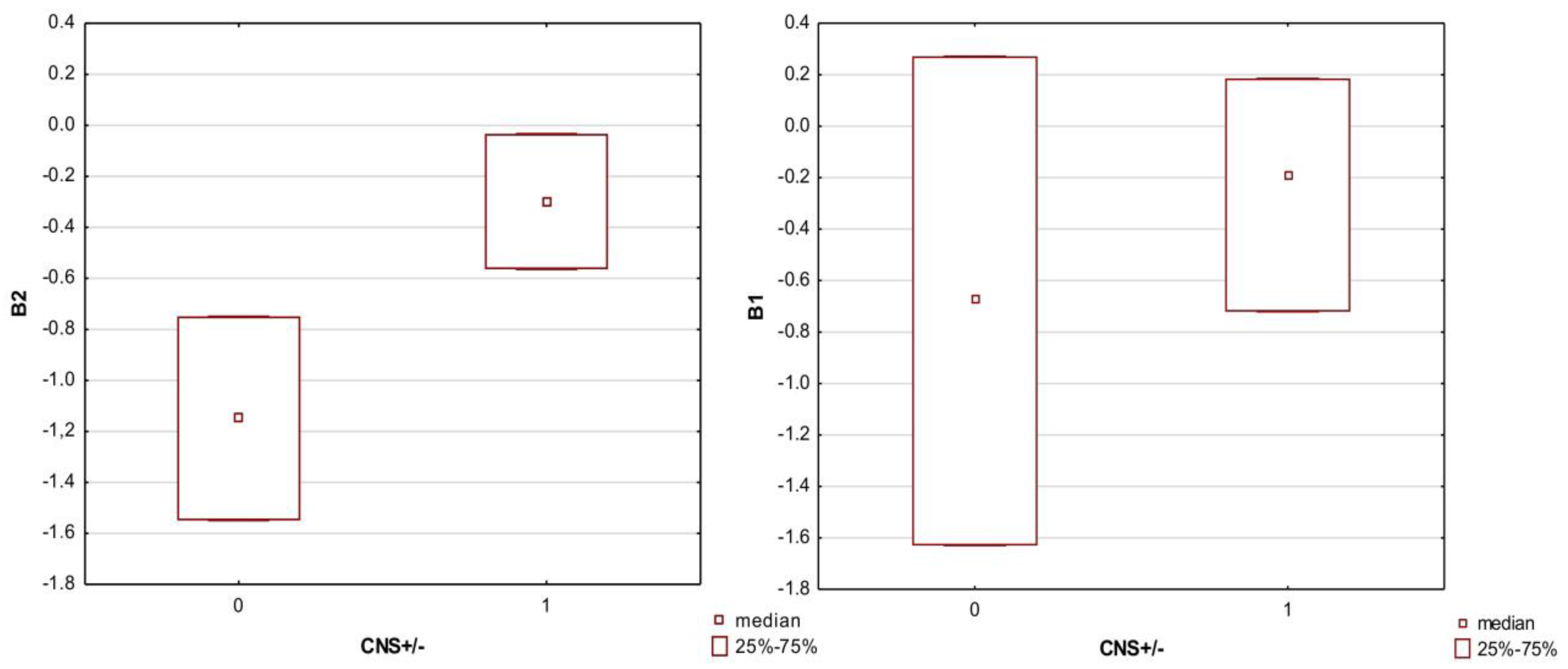
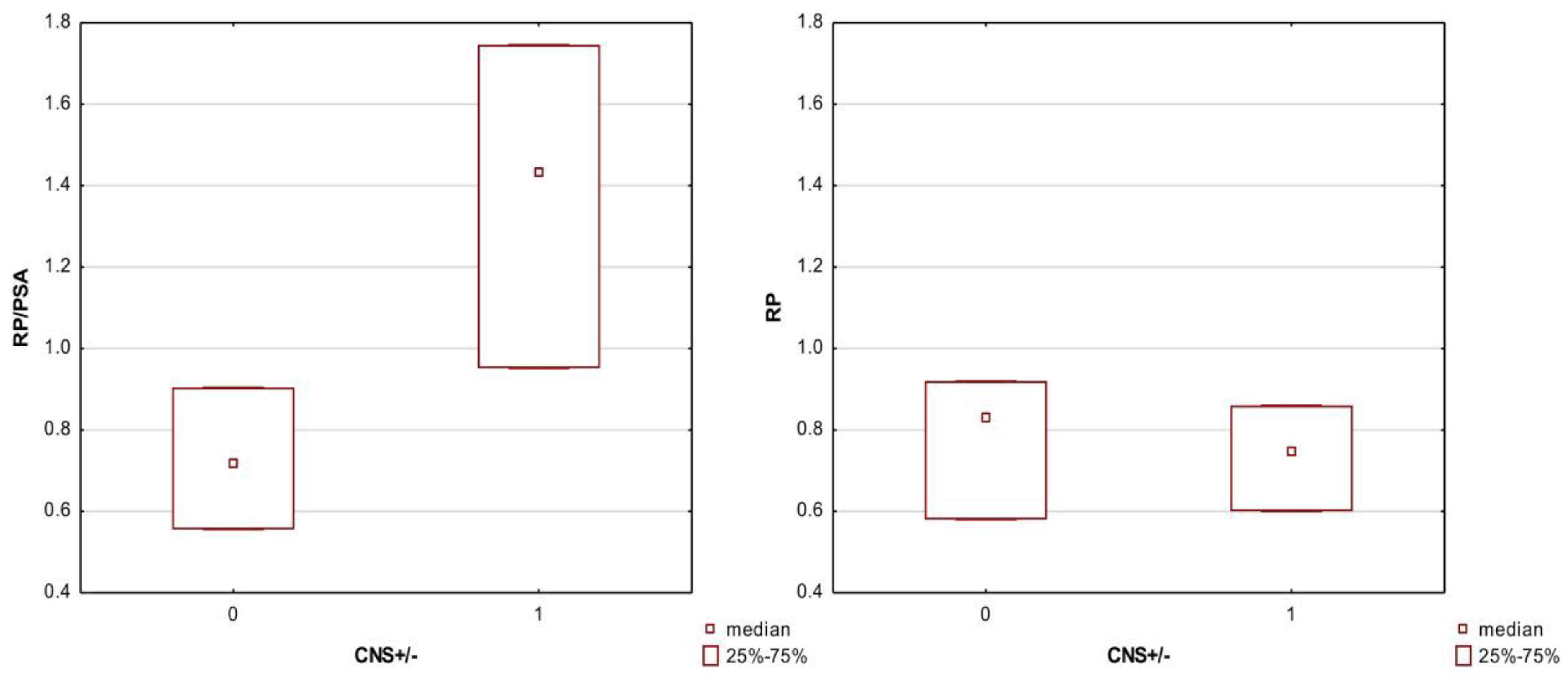


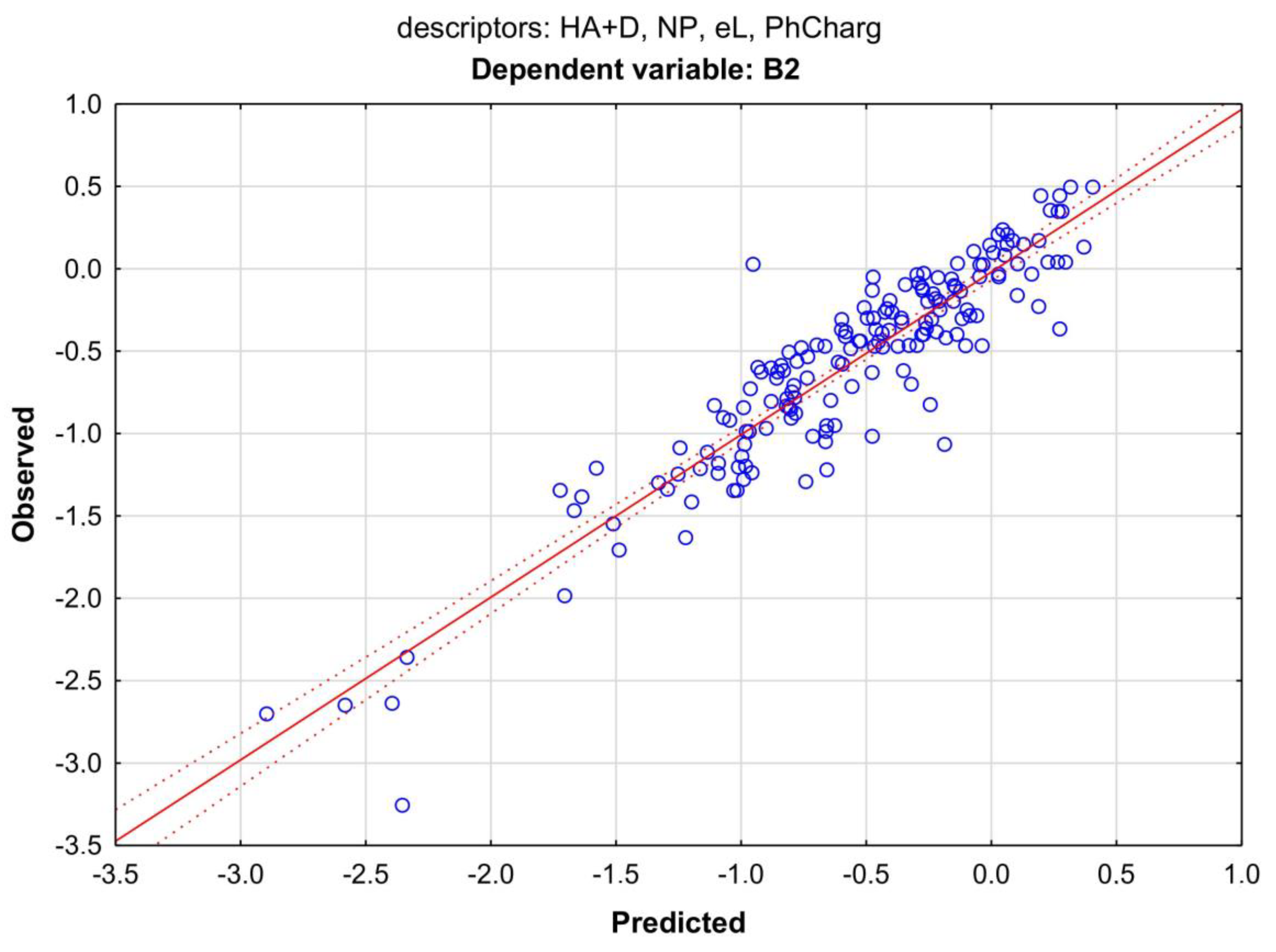
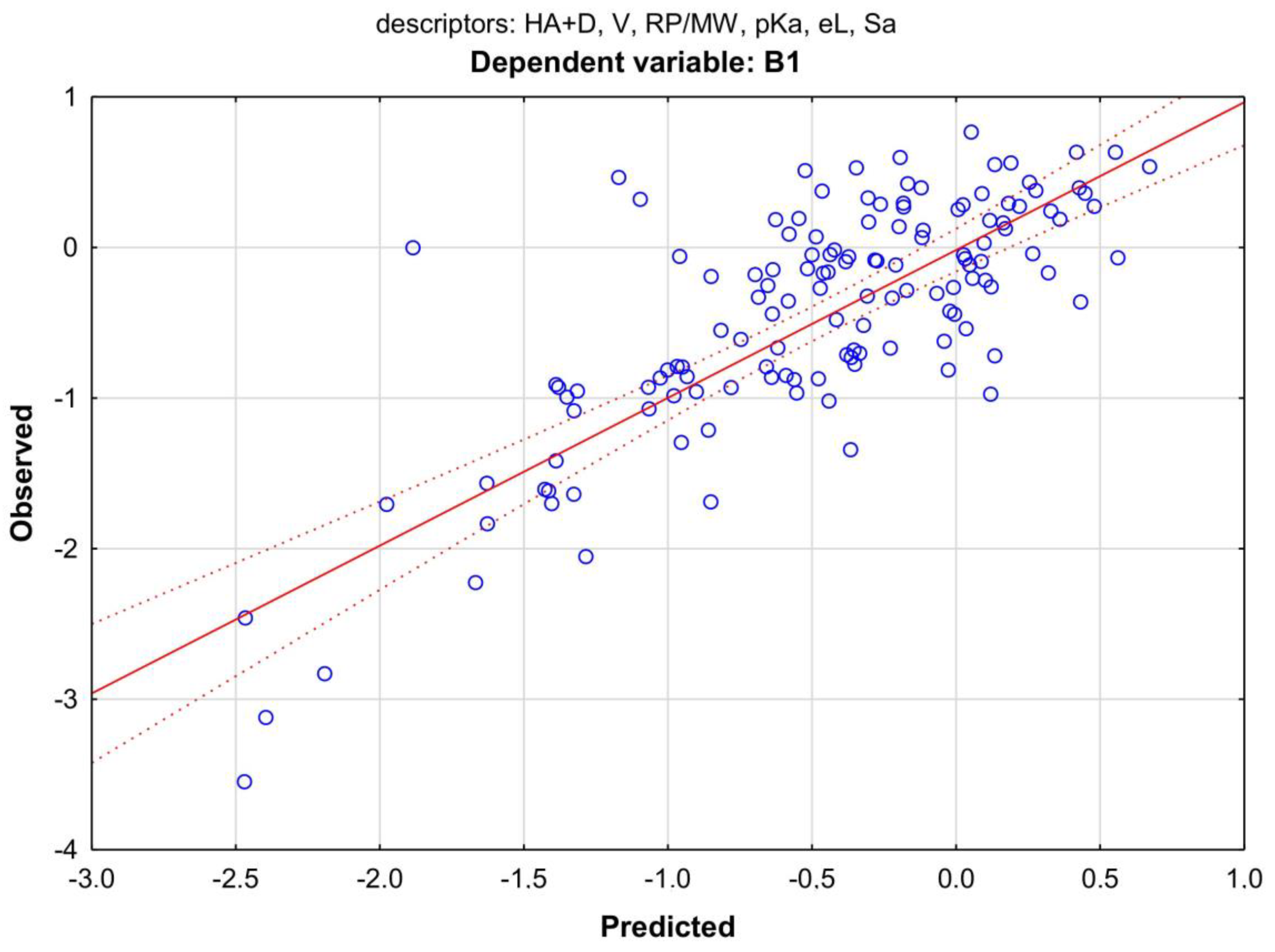
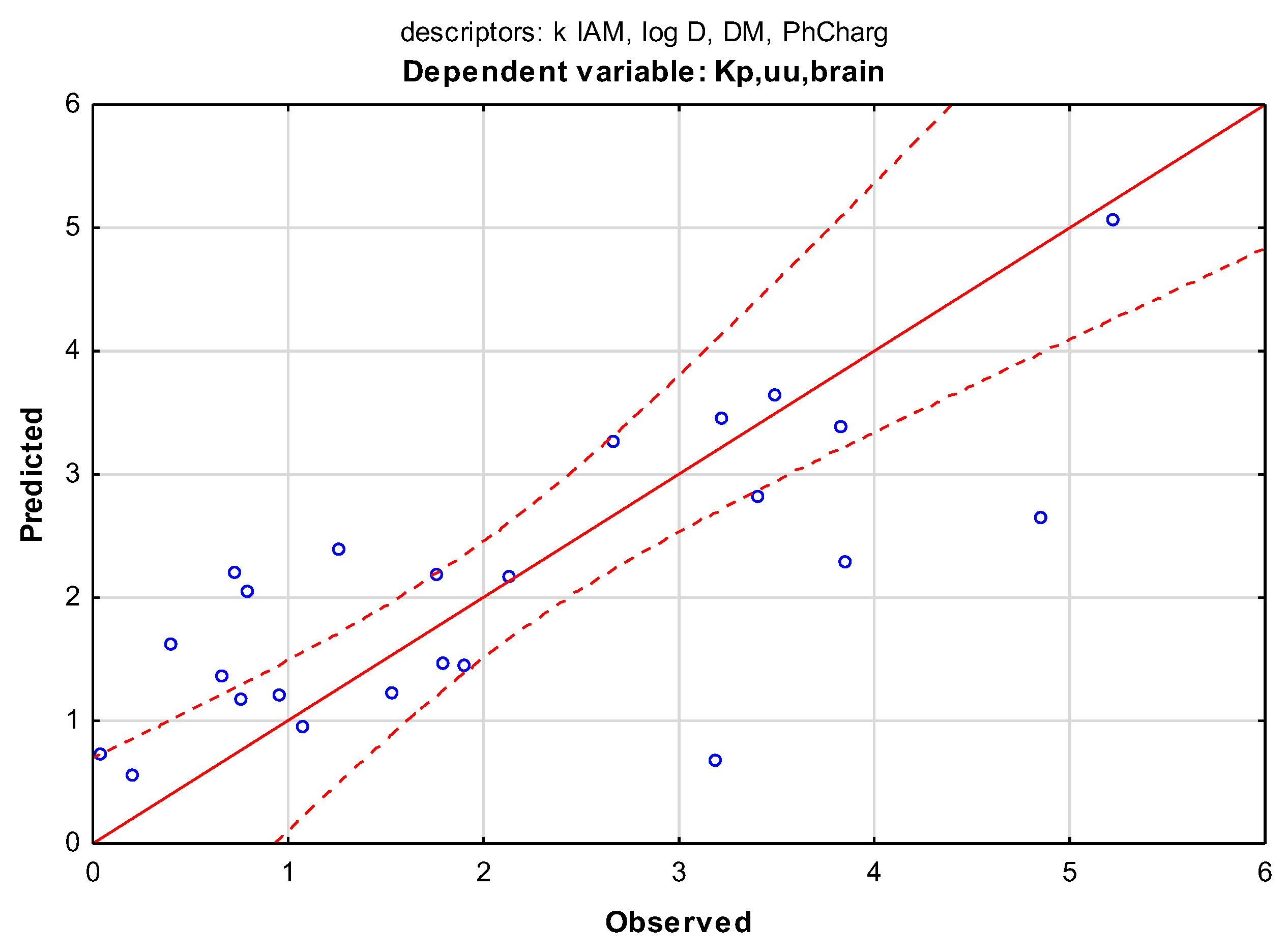
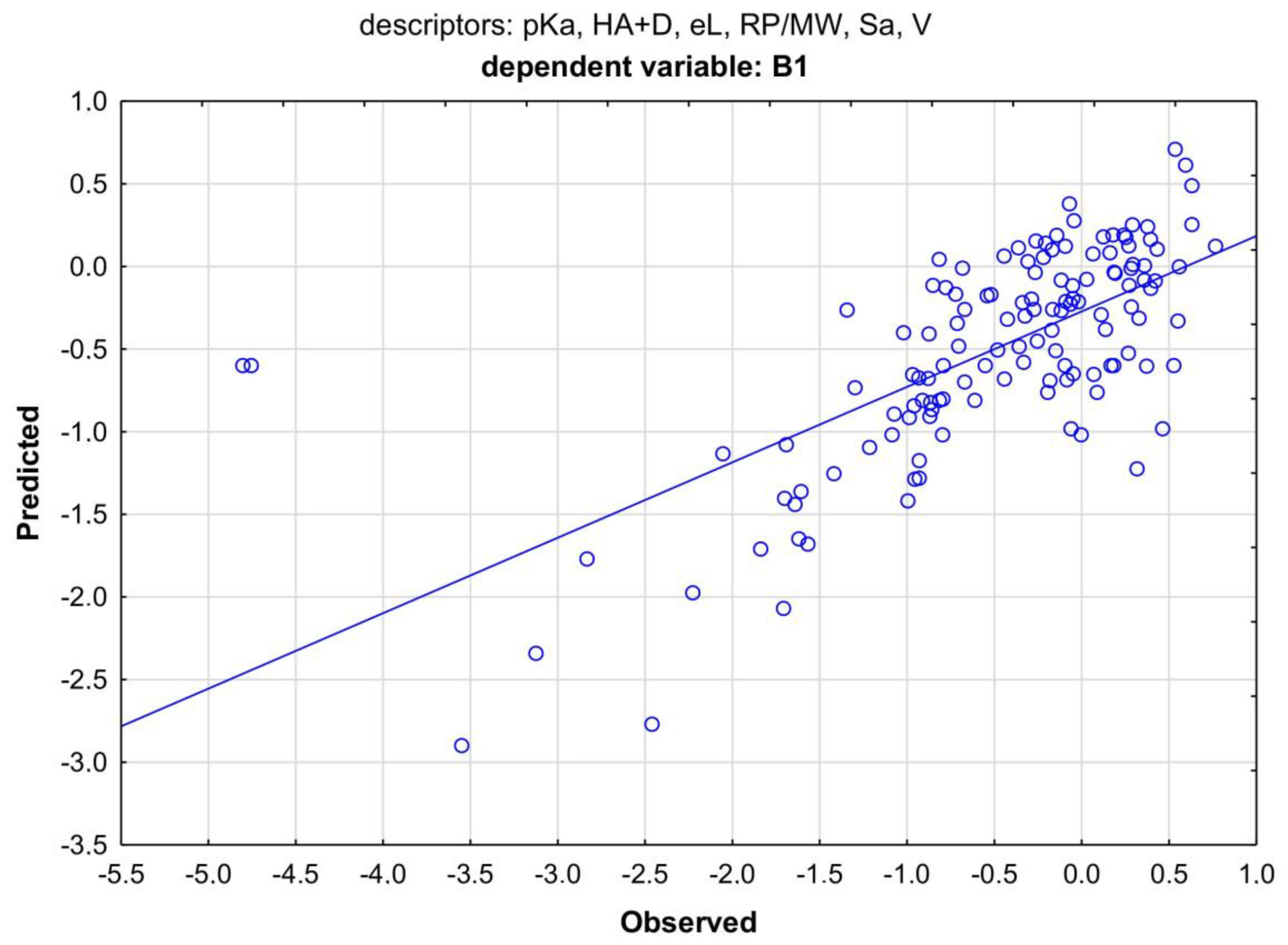
| Prediction of BBB Penetration | |
|---|---|
| In Silico | In Vitro |
| Solvation free energies in various solvents of different polarities [12] | Single endothelial cell monolayer model [13] |
| 1D, 2D, and 3D molecular descriptors and fingerprints of a molecule [14] | Stem cell modeling of the BBB: neural progenitor cells (NPCs), the precursors to neurons, astrocytes or oligodendrocytes [15] |
| Molecular descriptors: carboxylic acid group, polar surface area (PSA)/hydrogen-bonding ability, lipophilicity, and molecular charge [16] | Co-culture model (brain microvascular endothelial cells: BMECs with astrocytes or pericytes) [17] |
| 1D and 2D physicochemical properties, molecular access system fingerprints -MACCS and substructure fingerprints [18] | The microfluidic BBB [13]—microfluidic devices to mimic biological environments: -observation of specific markers of TJs [19] -measuring TEER [20] -permeability assessment [21] |
| HPLC data (IAM, HSA and AGP columns) and molecular descriptors to model brain disposition of drugs: Kp,uu,brain [11] | |
| MD | Description | Source |
|---|---|---|
| B2 | Computational parameter, determines penetration through the blood–brain barrier: log BB = 0.547 − 0.016 PSA | [7,28] |
| B1 | Computational parameter, corresponds to log BB | SwissADME |
| CNS+/− | Describes the bioavailability in the CNS | Drugbank |
| eL | Energy of the lowest unoccupied molecular orbital | Hyperchem |
| eH | Energy of the highest occupied molecular orbital | Hyperchem |
| eL-eH | Ionization capacity | Hyperchem |
| HA | Hydrogen bond acceptors | Hyperchem |
| HD | Hydrogen bond donors | Hyperchem |
| Kp,uu,brain | Unbound brain-to-plasma drug partition coefficient | [30] |
| log D | Distribution coefficient | ACD Labs |
| log k IAM | Logarithm of retention factor from HPLC IAM | HPLC |
| log P | Partition coefficient | Hyperchem |
| log U/D | Describes the extent of ionization, calculated from pKa, according to the equations: pKa—pH (acids) or pH—pKa (bases) | ACD Labs |
| MW | Molecular weight | Hyperchem |
| NP | The Rf from NP TLC plate | TLC |
| PB | Protein binding | Drugbank |
| PhCharg | Charge of a compound in physiological environment | Drugbank |
| PSA | Polar surface area of a molecule | Hyperchem |
| RP | The Rf from RP-2 TLC plate | TLC |
| Sa | Surface area of a molecule | Hyperchem |
| V | Molecular volume | Hyperchem |
| B2 | B2 > −0.52 | B2 > −0.9 | |
|---|---|---|---|
| RP | R = 0.9214 R2 = 0.8643 R2 adj. = 0.8589 F(5, 158) = 200.15; p > 0.000 N = 164 | R = 0.7374 R2 = 0.5433 R2 adj. = 0.5091 F(6, 82) = 16.18; p > 0.000; N = 89 | R = 0.8432 R2 = 0.7112 R2 adj. = 0.6924 F(6, 104) = 42.27; p > 0.000 N = 111 |
| RP derivatives | RP derivatives do not enter the model | R = 0.7287 R2 = 0.5422 R2 adj. = 0.5133 F(4, 84) = 24.24; p > 0.000 N = 89 derivative: RP/MW | R = 0.7842 R2 = 0.6011 R2 adj. = 0.5924 F(4, 106) = 40.30; p > 0.000 N = 111 derivative: RP/V |
| NP | R = 0.9332 R2 = 0.8713 R2 adj. = 0.8591 F(5, 158) = 240.15; p > 0.000 N = 151 | NP does not enter the model | R = 0.8572 R2 = 0.7412 R2 adj. = 0.7156 F(7, 103) = 41.43; p > 0.000 N = 111 |
| NP derivatives | R = 0.9322 R2 = 0.8734 R2 adj. = 0.8555 F(6, 144) = 160.07; p > 0.000 N = 151 derivative: NP/MW | R = 0.7813 R2 = 0.6122 R2 adj. = 0.5843 F(7, 81) = 18.249; p > 0.000 N = 89 derivative: NP/MW | R = 0.8142 R2 = 0.6481 R2 adj. = 0.6343 F(5, 105) = 38.703; p > 0.000 N = 111 derivative: NP/V |
| N = 143 | Mean | SD | B1 | B2 | B2 > −0.9 | B2 > −0.52 |
|---|---|---|---|---|---|---|
| B1 | −0.4901 | 0.9472 | 1.0000 | 0.5192 | 0.3776 | 0.3350 |
| B2 | −0.6152 | 0.6802 | 0.5192 | 1.0000 | 0.7832 | 0.7491 |
| B2 > −0.9 | 0.7273 | 0.4469 | 0.3776 | 0.7832 | 1.0000 | 0.6708 |
| B2 > −0.52 | 0.5455 | 0.4997 | 0.3350 | 0.7491 | 0.6708 | 1.0000 |
| B2 | B2 > −0.52 | B2 > −0.9 | |
|---|---|---|---|
| log k IAM | R = 0.9521 R2 = 0.8938 R2 correct. = 0.8877 F(5, 118) = 197.87; p < 0.000 N = 124 | R = 0.8687 R2 = 0.7644 R2 correct. = 0.7456 F(5, 60) = 37.67; p < 0.000 N = 66 | R = 0.8933 R2 = 0.8024 R2 correct. = 0.7714 F(9, 73) = 31.85; p < 0.000 N = 83 |
| log k IAM derivatives | log k IAM derivatives do not enter the model | R = 0.8742 R2 = 0.7633 R2 correct. = 0.7434 F(5, 60) = 37.15; p < 0.000 N = 66 derivative: log k IAM/PB | log k IAM derivatives do not enter the model |
| NP | RP | log k IAM | |
|---|---|---|---|
| MLR | R2 = 0.8743 R2 correct. = 0.8633 N = 151 | R2 = 0.8574 R2 correct. = 0.8642 N = 164 | R2 = 0.8912 R2 correct. = 0.8895 N = 124 |
| MARSplines | R2 = 0.8533 R2 correct. = 0.8524 N = 169 | R2 = 0.8218 R2 correct. = 0.8242 N = 169 | R2 = 0.8944 R2 correct. = 0.8891 N = 116 |
| Descriptors in the models | HA + D, NP, eL, PhCharg | HA + D, eL, RP, log P, PhCharg | HA + D, eL, log U/D, log k IAM, MW |
Disclaimer/Publisher’s Note: The statements, opinions and data contained in all publications are solely those of the individual author(s) and contributor(s) and not of MDPI and/or the editor(s). MDPI and/or the editor(s) disclaim responsibility for any injury to people or property resulting from any ideas, methods, instructions or products referred to in the content. |
© 2023 by the authors. Licensee MDPI, Basel, Switzerland. This article is an open access article distributed under the terms and conditions of the Creative Commons Attribution (CC BY) license (https://creativecommons.org/licenses/by/4.0/).
Share and Cite
Wanat, K.; Brzezińska, E. Chromatographic Data in Statistical Analysis of BBB Permeability Indices. Membranes 2023, 13, 623. https://doi.org/10.3390/membranes13070623
Wanat K, Brzezińska E. Chromatographic Data in Statistical Analysis of BBB Permeability Indices. Membranes. 2023; 13(7):623. https://doi.org/10.3390/membranes13070623
Chicago/Turabian StyleWanat, Karolina, and Elżbieta Brzezińska. 2023. "Chromatographic Data in Statistical Analysis of BBB Permeability Indices" Membranes 13, no. 7: 623. https://doi.org/10.3390/membranes13070623
APA StyleWanat, K., & Brzezińska, E. (2023). Chromatographic Data in Statistical Analysis of BBB Permeability Indices. Membranes, 13(7), 623. https://doi.org/10.3390/membranes13070623






